Case Studies
What are municipalities doing to address brownfields?
The Green Municipal Fund has a database of case studies from across Canada available here. What follows are examples of how municipalities in Alberta are championing brownfield redevelopment.
City of Calgary
The City of Calgary’s (The City) Municipal Development Plan (MDP) includes a goal to encourage brownfield redevelopment. Redeveloping brownfields allows for the re-use of land, supports urban densification, stimulates community revitalization, increases property values and reduces health and environmental risks.
City owned sites
In 2015, redevelopment of a contaminated City-owned property in a residential community in northwest Calgary resulted in a developer buying the property with the intention of building a 4-storey mixed-use commercial/residential destination. The City also led an interim (temporary) use project that repurposed a derelict tennis court into the Twin Views Communal Garden, which is a meeting space and garden education centre for surrounding communities. A dedicated team of volunteers manages the project with oversight from the City.
In 2016, The City's Quarry Park Recreation Centre was completed. This facility was constructed on a former quarry/industrial area and is part of the large scale brownfield redevelopment in south Calgary.
In 2012, The City acquired the former Cargill industrial site. This site operated as a grain terminal from 1914-2011 and was decommissioned shortly after operations ceased. The site, located immediately adjacent to the Bonnybrook Waste Water Treatment Plant, was purchased for the purposes of expanding the plant. In 2016, construction of a dewatering facility commenced; this is the first of several buildings that will be eventually built on this former brownfield site.
Interim use
The City continues to pursue interim-use options on sites where it is not feasible to fully remediate the contamination, but where there are opportunities for temporary uses that facilitate economic development while providing access to the land for monitoring and potential future remediation. For example, the City is piloting interim use of contaminated land near a light rail transit (LRT) station by locating a coffee shop in a shipping container on the land. The Southern Alberta Institute of Technology (SAIT) was engaged to conduct market research that the City hopes will demonstrate the viability of placing small businesses in modular structures on brownfield sites.
Working with the private sector
The City seeks to support redevelopment of privately owned land. There are many examples of redeveloped brownfield sites in Calgary. These sites range from former gas stations and drycleaners to large-scale sites, such as East Village (former industrial area), Garrison Woods and Currie Communities (former military base), Telus Spark Science Centre (former landfill), Quarry Park (former gravel pit/industrial area) and Deerfoot Meadows (former fertilizer plant).
To facilitate responsible brownfield redevelopment, The City conducts environmental development reviews. These reviews require applicants to demonstrate that that the environmental site conditions are suitable for the intended use. The City may also engage Alberta Health Services and Alberta Environment and Parks to ensure redevelopment will meet the applicable regulatory requirements. The City has recognized the technical challenges associated with brownfield redevelopment and has prepared the “Guidebook to Developing Contaminated Sites (2012)” to assist developers navigate this process.
Based on the lessons in redeveloping its own brownfield sites, the City seeks to support redevelopment of privately owned land by providing advice and working with Alberta Health Services and Alberta Environment and Parks to coordinate the approval process.
Many brownfield sites remain in an underutilized state, however, and The City continues to pursue opportunities for redevelopment. Two examples of sites that could potentially be redeveloped are the Former Imperial Oil Refinery Site and the West Village area.
The City is working with Imperial Oil Limited to return a former refinery site to a productive community use (e.g outdoor recreation space and public transit infrastructure). After receiving approval from Alberta Environment and Parks 2014, The City and Imperial Oil Limited began a three-year remediation project to clean up the soil and groundwater. In 2015, a water treatment system was installed to clean the groundwater. Crews also built an underground barrier wall along the riverbank to prevent the contaminants from entering the river. This work is an important step in protecting the environment and restoring the land to a point where it can be repurposed for the benefit of surrounding communities.
In 2010, the West Village Area Redevelopment Plan was plan was approved. This plan outlines a vision for redevelopment of the west end of downtown that has a long history of past and present industrial/commercial uses, including the former Canada Creosote Site. The plan area is located adjacent to the Bow River and is envisioned to be redeveloped into a mixed use community. Over the last few years, The City has completed several investigations on the former Canada Creosote site located. The most recent investigations examined the efficacy of the current containment system, provided recommendations for improvement on the water treatment system design and operations, and presented options for potential remediation of the site. The environmental investigations completed to date will help determine how the redevelopment plan could be potentially implemented.
To learn more about the City's approach to brownfield redevelopment click here to review their Guidebook to Developing Contaminated Sites.
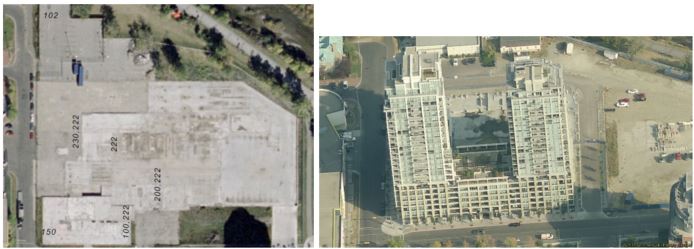
Redevelopment of former bus barns into a condominium complex in the City of Calgary
City of Edmonton
The City of Edmonton is recognized nationally for its leadership in brownfield redevelopment. As is the case in most municipalities in Alberta and across Canada, former refueling sites pepper the municipality. In many cases, prohibitive costs for remediation render these sites, which sit in prominent locations, underutilized, aesthetically unpleasing, economically damaging and environmentally contaminated.
Brownfield Redevelopment Grant Program
To accelerate the return of brownfields to productive use, the City has rolled out a Brownfield Redevelopment Grant Program. A task force of City councillors worked closely with a multidisciplinary staff team to create the program, which drew on extensive research into best practices in Canada and beyond, as well as consultation with local property owners, developers and industry experts. The resulting program offers grants for all stages of brownfield remediation and includes environmental performance incentives. Initially developed with support from FCM's Green Municipal Fund, the program’s long-term funding model is based on municipal tax uplift from the increased tax revenue of a redeveloped property for a maximum of six years.
As a result, many of the sites that the City has identified in an inventory of contaminated sites have been remediated; and this number continues to grow. The program has been recognized with awards from the Canadian Urban Institute, Alberta Municipal Affairs and FCM. A detailed profile of the program is on FCM’s website here. Edmonton is sharing its success with other municipalities by participating in the Green Municipal Fund’s Leadership in Brownfield Renewal (LiBRe) program, a network of Canadian municipalities committed to bringing brownfield sites back into productive use. The Town of Mayerthorpe has used Edmonton’s Brownfield Redevelopment Grant program as a model for its own.
Environmental Site Assessment Guidebook
In addition to the grant program, the City has released an Environmental Site Assessment Guidebook which provides an outline of the process required for Land Development Applications to determine if site conditions are suitable for their intended purpose. The guide provides clear expectations of site owners and potential developers in terms of demonstrating environmental due diligence required to meet City and provincial standards.
Brownfield Coordinator
The City has also established a Brownfield Coordinator position to act as a single point of contact for any brownfield related inquiry. The Coordinator creates networks across the City’s various departments in order to tailor support to help projects move more efficiently through the redevelopment process.
For more information visit the City of Edmonton’s brownfield redevelopment webpage.
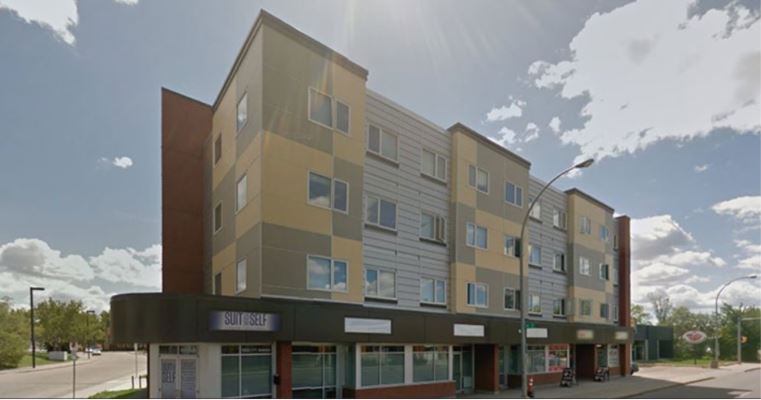
Redevelopment of a former refueling station into a mixed-use complex offering below-market rent in the City of Edmonton
Town of Mayerthorpe
The Town of Mayerthorpe adopted a Brownfield Redevelopment Strategy in 2015, which focuses on providing financial support to private owners of brownfield sites, and identifying and redeveloping municipally owned brownfield sites.
Brownfield Redevelopment Grant Program
In 2016, Mayerthorpe launched a Brownfield Redevelopment Grant Program, which provides funding to help private landowners conduct the environmental site assessments (ESAs) required to determine whether or not a site is contaminated and what further steps need to be taken if it is. The grant program is modelled on the City of Edmonton’s. Up to $1,000 is available for Phase I ESAs, which involve reviewing historic and present-day uses of a site to determine whether these uses may have caused contamination. Up to $5,000 is available for Phase II ESAs which confirm the presence, absence or level of contamination. The grant can also be used to remove, treat or otherwise manage contamination found on the site.
In addition to promoting the grants in the local paper, the Town’s newsletter and website, the Town also sent letters to owners of potential brownfield sites inviting them to participate in the program. To date, uptake on the program has been slow, so the Town is turning its attention to municipally-owned brownfield sites in hopes that it can lead by example and inspire private landowners to take action.
Municipally owned brownfield sites
As part of its Brownfield Redevelopment strategy, the Town is focusing on redeveloping municipally-owned sites, so that it can demonstrate the redevelopment process to the private sector. To start, the Town worked with Alberta Environment and Parks to identify and map all municipally-owned sites that are potentially contaminated. As a next step the Town has identified a couple of sites where there are good opportunities for redevelopment. For example, the Town has completed a risk assessment of properties within 300 metres of an old landfill in order to better understand the extent of contamination, how much remediation is required and feasible and what redevelopment opportunities may be appropriate for the site. While full redevelopment of the landfill and surrounding area is not possible, the Town is currently exploring interim uses such as parks and non- permanent structures (e.g. information booths) which allow for beautification and use of the sight, while at the same time providing the access needed for ongoing monitoring and management of contamination.
Leadership and networking
Brownfield redevelopment is being championed by Mayerthorpe’s Mayor and Council, who have approved dedicated funding for redevelopment initiatives. Implementation of the strategy is being led by Mayerthorpe’s CAO, who has joined the Green Municipal Fund’s Leadership in Brownfield Redevelopment Network to connect with brownfield experts from across Canada and access a wide array of redevelopment resources.
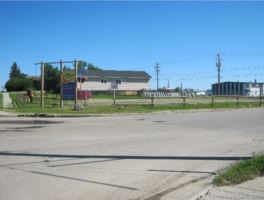
Brownfield project site in Mayerthorpe
Town of Okotoks
The Town of Okotoks has successfully overseen the acquisition, partition and development of a large scale brownfield site.
Former sour gas plant
In the early 2000s, a quarter section of land was donated to the Town by an oil and gas company. The site had housed a sour gas plant and sulphur storage facility. Before transferring the land, the company had done the environmental site assessments to determine the impacts of the previous use on the site and actions necessary to develop the site for another use. The company remediated the site so that it met provincial standards for industrial development.
Land dedication and partition
At the time of purchase, the site was partitioned into four areas. Approximately four acres of land that had not been contaminated was dedicated as municipal reserve and developed into a municipal park. An adjacent escarpment was dedicated as environmental reserve, which has been integrated into the Town’s corridor of natural areas. The portion of the site formally occupied by the sour gas facility, containing 57 acres, was developed into a dog park and 71 acres of the site formerly used for sulphur storage were remediated to allow for industrial development.
Restrictive covenant
Despite having remediated the land, the company was concerned it could face future liability. Therefore, it placed a restrictive covenant on the remediated portion of the site, specifying the type of industrial development that is permissible. While the Town was pleased to be able to convert the site into an industrial park, the restrictive covenant has posed challenges. For example, the covenant allows for gas bars, but not convenience stores. The Town had to work closely with the previous owner and a fuel company wanting to build a full service gas station in order to expand the covenant to allow this type of development. Similar additions to the covenant have been made on a site by site basis and require close communication between the municipality, the previous owner and project proponents. Despite these challenges, over half of the industrial park has been sold and development continues. This has helped to diversify the economy, creating new jobs and increasing the municipal tax assessment base.
Community facility
Despite the previous owner’s concerns about liability, the Town was able to develop a baseball diamond on a portion of the site that had previously served as a storage facility. A local philanthropist provided funding for the building and served as a champion for the site, convincing the previous owners to expand the covenant to allow the development of an important community facility.
Monitoring
As part of the transfer agreement, the Town assumed responsibility for monitoring the site to ensure any remaining contamination does not exceed standards or migrate to non-contaminated portions of the site or adjacent lands. A schedule for monitoring wells was set out in the agreement.
Redevelopment of the land has been a long process, which continues to this day. The willingness of the municipality and company to maintain close communication throughout the process has provided the Town with economic development opportunities and community amenities.
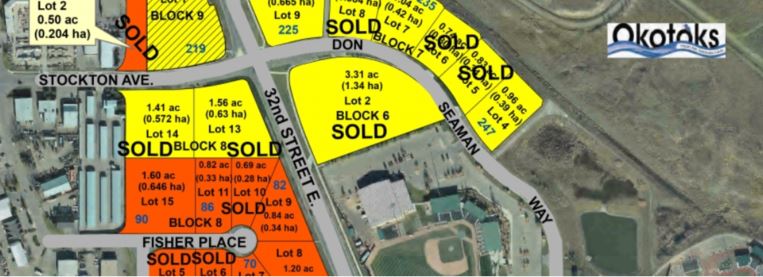
Redevelopment of a former sour gas plant into an industrial park in the Town of Okotoks
Town of Vulcan
Solar Park
The Town of Vulcan is in the process of completing the remediation and redevelopment of two abandoned former bulk fuel stations. These sites represent common issues posed by brownfields; they were contaminated, under-used and visually unappealing. Vulcan wanted to re-purpose the sites and develop a Solar Park, the first of its kind in Canada. The Park is located in downtown Vulcan, is highly visible, and will produce electricity while at the same time providing an aesthetically pleasing space for the community to gather.
Procurement of the two sites was the most difficult and time-consuming portion of the process, as liability issues and contamination created hurdles for the Town. The sites were remediated by soil replacement and will be monitored for the life of the park to ensure that any residual contamination does not migrate to other properties or to the surface of the site. Once procurement and remediation were accomplished, installation of the solar components took place in the spring of 2016, and early summer 2016 saw germination of the grass. The design and development of the Vulcan Solar Park involved local students, and the site will include learning modules on solar power to continue to educate after its completion. Funding for the site was received from Alberta Energy Innovation Fund and partnership with two private companies.
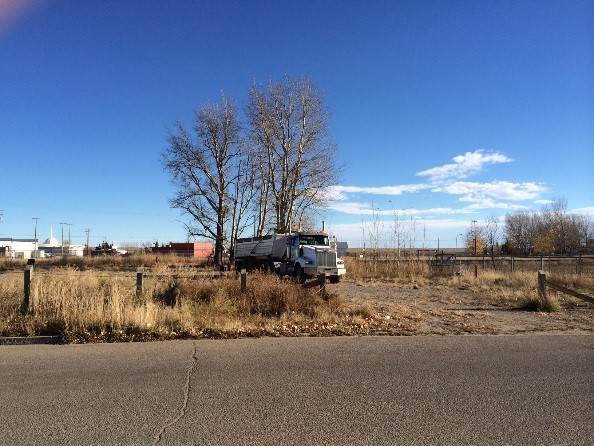
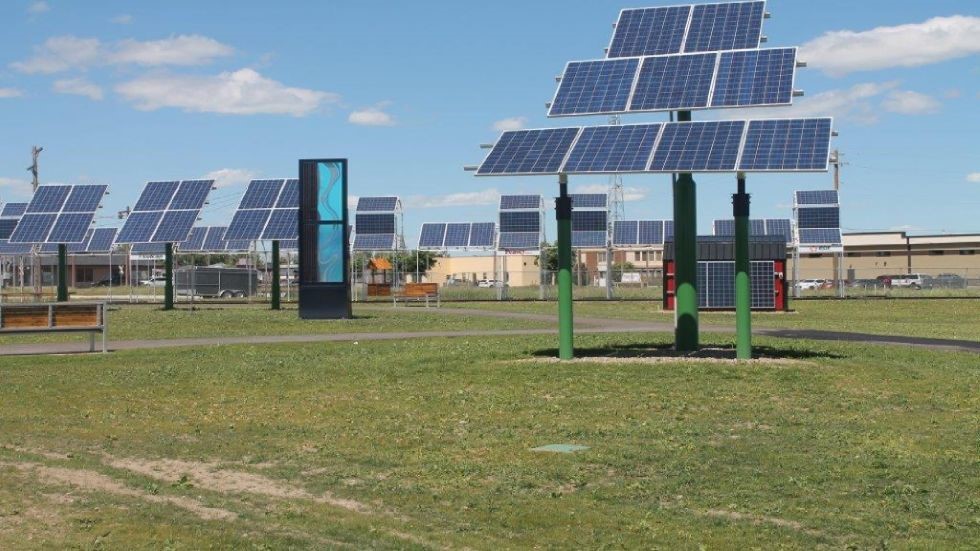
Redevelopment of a former bulk fueling station into a solar park